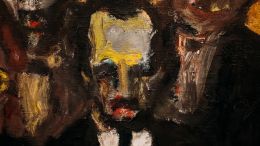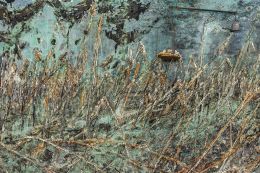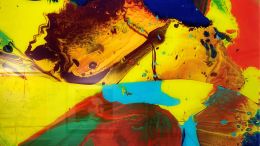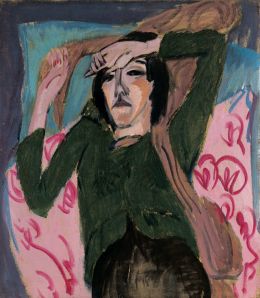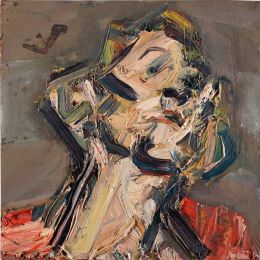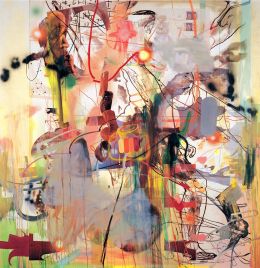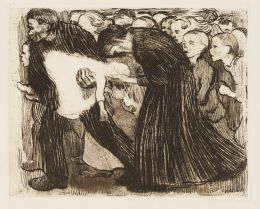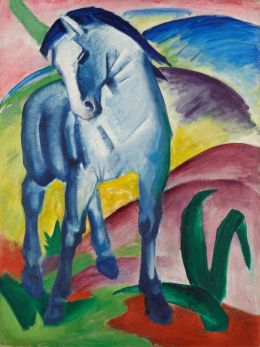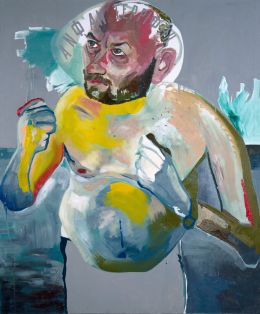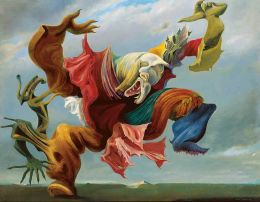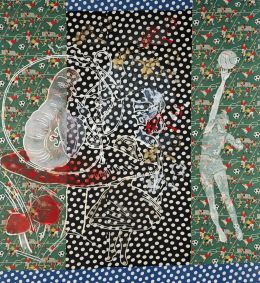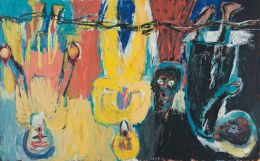- 1867 - 1956German
Emil Nolde (born Hans Emil Hansen; 7 August 1867 – 13 April 1956) was a German-Danish painter and printmaker. He was one of the first Expressionists, a member of Die Brücke, and was one of the first oil painting and watercolor painters of the early 20th century to explore color. He is known for his brushwork and expressive choice of colors. Golden yellows and deep reds appear frequently in his work, giving a luminous quality to otherwise somber tones. His watercolors include vivid, brooding storm-scapes and… more
- 1945German
Anselm Kiefer (born 8 March 1945) is a German painter and sculptor. He studied with Peter Dreher and Horst Antes at the end of the 1960s. His works incorporate materials such as straw, ash, clay, lead, and shellac. The poems of Paul Celan have played a role in developing Kiefer's themes of German history and the horrors of the Holocaust, as have the spiritual concepts of Kabbalah.
In his entire body of work, Kiefer argues with the past and addresses taboo and controversial issues from recent… more
- 1932German
Known for his use of both photorealism and abstraction in painting, often simultaneously, Gerhard Richter is one of the most important artists working today. Born on 9 February 1932 in Dresden, he began his career as an advertisement and stage painter before attending art school first in Dresden, then in Dusseldorf. The significance of Richter’s career and body of work is evident in his many solo exhibitions at museums worldwide, including at the Museum of Modern Art, New York; National Portrait Gallery, London; and National Art Museum of China, Beijing. Further, his work… more
- German
Ernst Ludwig Kirchner (6 May 1880 – 15 June 1938) was a German expressionist painter and printmaker and one of the founders of the artists group Die Brücke or "The Bridge", a key group leading to the foundation of Expressionism in 20th-century art. He volunteered for army service in the First World War, but soon suffered a breakdown and was discharged. His work was branded as "degenerate" by the Nazis in 1933, and in 1937 more than 600 of his works were sold or destroyed.
- 1931British, German
One of Britain's preeminent post-war painters, Frank Auerbach was born in Berlin, Germany in 1931. Arriving in England as a Jewish refugee in 1939, he attended St Martin's School of Art, London, and studied with David Bomberg in night classes at Borough Polytechnic. He then studied at the Royal College of Art and has remained in London ever since. His first exhibition was held at London's Beaux Arts Gallery in 1956; since then his works have become some of the most internationally collected of living artists.
Auerbach's organic, yet unified forms are deeply rooted in… more
- 1954German
Albert Oehlen, born in 1954 in Krefeld, is a German painter living and working in Cologne, Germany. Marked by freedom and creativity, Oehlen’s oeuvre is characterized by expressionist brushwork, écriture automatique, the history of abstraction and an ongoing quest for new extremes.
In the 80s, Oehlen became a dominant figure in the Berlin and Cologne art scene, alongside the Neue Wilde such as Martin Kippenberger or Werner Büttner. The German artist attempts to deconstruct the medium, investigating painting’s most essential aspects such as colour, the brushstroke as… more
- 1867 - 1945German
Born in the Prussian city of Königsberg (now Kaliningrad, Russia) in 1867, Käthe Kollwitz established herself in an art world dominated by men by developing an aesthetic vision centered on women and the working class. Her representations of women, including her frequent self-portraits, effectively communicated her subjects’ predicaments during a period when women were still negotiating ways to represent themselves in the arts. While her naturalistic style appeared out of touch in an era that witnessed the birth of abstraction, her depictions of universal human experiences, given depth and… more
- 1880 - 1916German
Franz Moritz Wilhelm Marc (8 February 1880 – 4 March 1916) was a German painter and printmaker, one of the key figures of German Expressionism. He was a founding member of Der Blaue Reiter (The Blue Rider), a journal whose name later became synonymous with the circle of artists collaborating in it.
His mature works mostly depict animals, and are known for bright colouration. He was drafted to serve in the German Army at the beginning of World War I, and died two years later at the Battle of Verdun.
In the 1930s, the Nazis named him a degenerate artist as part of their… more
- 1953 - 1997German
Martin Kippenberger (25 February 1953 – 7 March 1997) was a German artist known for his extremely prolific output in a wide range of styles and media, superfiction as well as his provocative, jocular and hard-drinking public persona.
Kippenberger was "widely regarded as one of the most talented German artists of his generation, according to Roberta Smith of the New York Times. He was at the center of a generation of German enfants terribles including Albert Oehlen, Markus Oehlen,… more
- 1891 - 1976German
Max Ernst (2 April 1891 – 1 April 1976) was a German (naturalised American in 1948 and French in 1958) painter, sculptor, graphic artist, and poet. A prolific artist, Ernst was a primary pioneer of the Dada movement and surrealism. He had no formal artistic training, but his experimental attitude toward the making of art resulted in his invention of frottage—a technique that uses pencil rubbings of objects as a source of images—and grattage, an analogous technique in which paint is scraped across canvas to reveal the imprints of… more
- 1941 - 2010German
Sigmar Polke (13 February 1941 – 10 June 2010) was a German painter and photographer.
Polke experimented with a wide range of styles, subject matters and materials. In the 1970s, he concentrated on photography, returning to paint in the 1980s, when he produced abstract works created by chance through chemical reactions between paint and other products. In the last 20 years of his life, he produced paintings focused on historical events and perceptions of them.
- 1938German
Georg Baselitz (born 23 January 1938) is a German painter, sculptor and graphic artist. In the 1960s he became well known for his figurative, expressive paintings. In 1969 he began painting his subjects upside down in an effort to overcome the representational, content-driven character of his earlier work and stress the artifice of painting. Drawing from myriad influences, including art of Soviet era illustration art, the Mannerist period and African sculptures, he developed his own, distinct artistic… more
